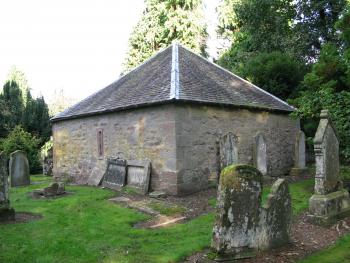- Navigation:
- Back to the Corpus index page
- RSS
Caputh Parish Church
Caputh Churchyard, Mackenzie of Delvine burial vault, from south east
- Dedication: unknown
- Diocese of Dunkeld
- Deanery of Angus
- County of Perthshire
- Perth and Kinross Council
- NO 0833 4000
Summary description
The eastern part of the shell of the medieval chancel is said to survive – albeit in much modified form - in the burial vault of the Mackenzie of Delvine family, towards the east end of the churchyard on what is known as the Mute Hill.
Historical outline
Dedication: unknown
According to Alexander Myln in his Vitae Dunkeldensis Ecclesiae Episcoporum, as a consequence of concerns over the transmission of pestilence within the large parish of Little Dunkeld caused by funeral parties crossing from its eastern portion east of the River Tay to the church on the west bank, and movement of people through Dunkeld itself, Bishop George Brown first established a cemetery at Caputh c.1500.(1) This was followed by a formal division of the parish, with a new parish church being established at Caputh, from which he shortly afterwards separated the northern portion which was largely Gaelic-speaking and founded a separate parish at Dowally. At Caputh, the bishop paid for the building and decoration of the choir, which was provided with a painted reredos and glazed windows. In the Granitar’s accounts for 1509-10 in the rental-book of the bishopric, there was a further discharge of 12 shillings noted for repairs to the windows at the churches of Caputh, Cargill and Dowally.(2)
Bishop Brown’s establishment of the new parish had been facilitated by his control of Little Dunkeld as one of his mensal churches. When setting up the new parish, he retained the parsonage revenues for himself, while the vicarage, which was annexed with the remainder of the vicarage perpetual of Little Dunkeld to the prebend of the treasurer of Dunkeld, was likewise retained in the hands of the prebendary.(3) Instead, Bishop Brown assigned a small vicarage which was annexed to the bishopric for the support of a vicarage pensionary. The canonry and prebend of Caputh in the cathedral of Dunkeld, recorded from 1437, appears to have been founded upon rental income from property rather than an allocation of teind from the district, a position which continued at the Reformation.(4) In the 1560s, the church was noted as pertaining to the episcopal mensa of Dunkeld.(5)
Notes
4. CSSR, iv, nos 364, 378a, 970; Kirk (ed.), Book of Assumptions, 318.
Architectural analysis
The church presently in use for worship dates from 1798, although much of what is now seen there dates from a succession of augmentations and modifications carried out in 1839, 1865, 1891 and 1918. The site of the medieval church was in the cemetery at Mute Hill, about half a kilometre to the west of the modern church, at NO 0833 4000. In the older part of this cemetery is an interesting group of gravestones dating from the seventeenth, eighteenth and nineteenth centuries.
Bishop George Brown’s payments for the building and furnishing of the choir, and for provision of a painted retable and windows, show that he took an active interest in the church he established at Caputh. Although now hardly recognisable as such, the much modified shell of the eastern part of his chancel is believed to have survived as the Mackenzie of Delvine burial vault, a structure of 7.2 metres square with a pyramidal roof. Its walls were presumably first adapted for this function after the new church had been built on a different site, though the rather ponderously Romanesque revival west face, and possibly much else as well, dates from a restoration of 1879. According to an enamelled plaque attached to the internal south wall, which states that the vault had been part of the church of about 1500, this work was carried out for Lady Muir Mackenzie.
It may be considered as a possibility that the line of the north wall of the nave is indicated by the location of the large and now free-standing aedicular monument of John Hagart of Glendelvine, a short distance to the west of the Delvine vault. If that were the case, this would suggest that Bishop Brown’s early sixteenth-century church had been a two compartment structure, with a nave wider than the chancel, since the monument is a little to the north of the line of the Delvine vault’s north wall. But this can be no more than speculation.
Bibliography
Calendar of Scottish Supplications to Rome 1433-47, 1983, ed. A.I. Dunlop and D MacLauchlan, Glasgow, nos 364, 378a, 970.
Cowan, I.B., 1967, The parishes of medieval Scotland, (Scottish Record Society), Edinburgh, 27.
Gifford, J., 2007, The Buildings of Scotland, Perth and Kinross, New Haven and London, 256.
Kirk, J., 1995, The books of assumption of the thirds of benefices, (British Academy) Oxford, 303, 344, 346.
Rentale Dunkeldense, 1915, ed. R.K. Hannay, (Scottish History Society), Edinburgh, 109.
Vitae Dunkeldensis Ecclesiae Episcoporum…Ad Annum Mdxv, 1823, ed. T. Thomson, (Bannatyne Club), Edinburgh, 42-3.
New Statistical Account of Scotland, 1845, Edinburgh and London, x, 682.
Royal Commission on the Ancient and Historical Monuments of Scotland, Canmore database.
Royal Commission on the Ancient and Historical Monuments of Scotland, 1994, South-East Perth, an archaeological landscape, Edinburgh, 132, 133-6, 162.
Statistical Account of Scotland, 1791-9, ed. J. Sinclair, Edinburgh, ix, (1793), 485-6.
Map
Images
Click on any thumbnail to open the image gallery and slideshow.











